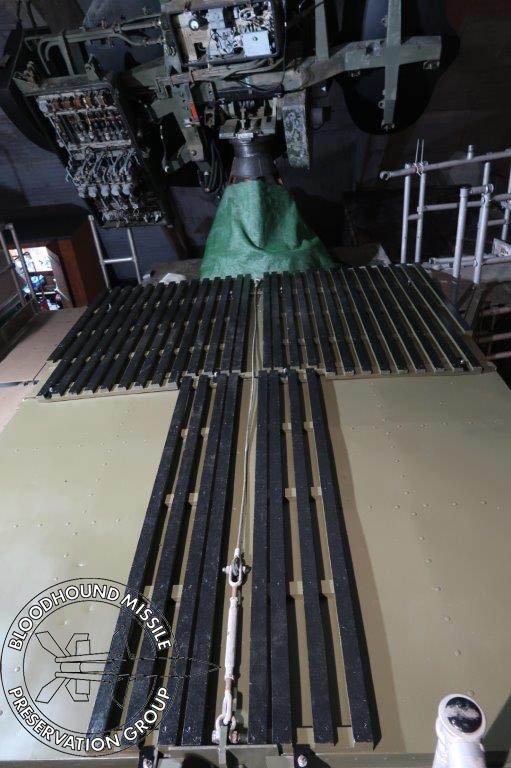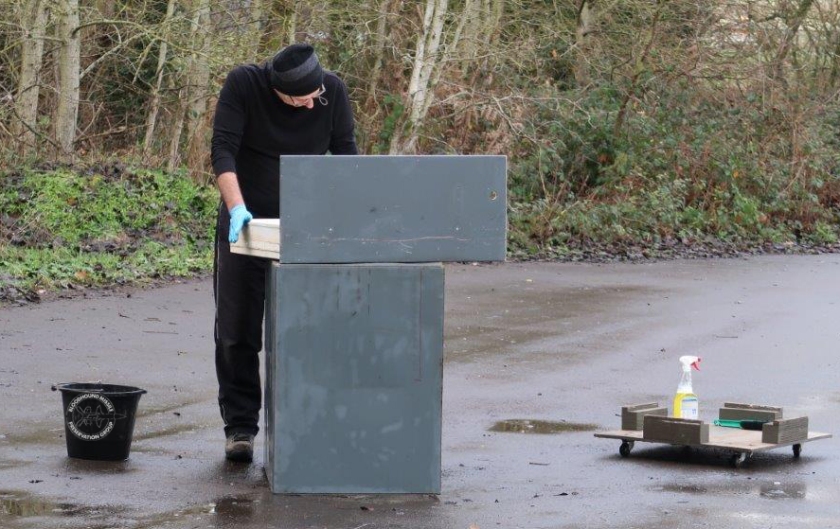The Bloodhound Missile Preservation Group (BMPG) is a team of mainly ex-Royal Air Force technicians who worked with Bloodhound and ex-Ferranti engineers, one of whom commissioned the updated Launch Control Posts (LCP) in 1985 and so brings a wealth of experience and knowledge to the team.
LCP Before Recovery
BMPG’s first acquisition. A long story of how we acquired the LCP and best told at a later date but it all started when it was known that I was interested in preserving Bloodhound equipment. I was motivated to try and preserve Bloodhound MKII following a visit to the IWM at Duxford, their Bloodhound kit was in a sorry state and still is. The photograph shows our LCP shortly before it was recovered, it had been abandoned by the RAF Museum in a far corner of the airfield at RAF Cosford. It had been there since it was moved from display when the Cold War building was erected at Cosford.

LCP Cabin Restored
Now under cover and protected by a dust sheet. Further work is still required in replacing various fittings but the major tasks in restoring the cabin have been completed, it has taken a few years!

The Simulator as Recovered
A major update programme from 1985 onwards to the Bloodhound MKII LCP when its Ferranti Argus 200 computer was replaced with the Argus 700. As a result of the update most of the displays were digitised and the Argus 700 was powerful enough to incorporate the simulator for Engagement Controller training in to the operational LCP. Our first task was to assess the viability of restoring the simulator and decided it was worth a go! One problem was that the display console was not complete, the top switch panel and the Engagement Controllers keyboard were both missing as can be seen in the photograph.

The Simulator Running
It took three years of restoration work before the first flicker of life returned to the LCP and its simulator. The simulator restoration is now complete after replacements for the missing items were located. The simulator runs exercises from basic target acquisition through to engaging multiple jamming targets The restoration was only possible through the support of many and kind donations. We also have a close working relationship with the Swiss Bloodhound museum at Menzingen whose support has made our restoration possible.

LCP Cabin internals
A general view of the LCP with the display console prominent. On the right are the racks to monitor the eight missiles of a Bloodhound section. Perhaps we will look to some restoration of the racks in the future and develop an eight channel missile simulator! Note the shiny handles on the rack draws, all 350 plus chrome fitting in the LCP have been re chromed!

Type 86 Radar Before Recovery
The Type 86 was acquired a couple of years after the LCP when the RAF Museum decided it was time to dispose of it. As with the LCP the radar had been abandoned, left to the elements and attacked by scrap metal hunters. We acquired the radar after the RAF Museum put it up for disposal and no one else wanted it, probably because it was described as a ‘derelict trailer’.

Type 86 Radar on 29th September 2018
The Type 86 today with restoration well under way. Some significant work has been undertaken including replacing its plywood floor, completely rotten following years in the open with the cabin doors left open. Some electronics restoration has taken place as we needed to get the aerial brake system working but the radar will never transmit again. We are looking at some simulation and hopefully bring life back to the control and signal circuits.

Project Status
The missing items for us are a Bloodhound missile and launcher which would complete the set. Both missiles and a Launcher exist at a couple of accredited Museum locations but are no longer on display; they have been left in the open and are deteriorating fast.
We have made representations to both locations to save this equipment so they can go on public display with our LCP and Type 86 Radar but no positive response has yet been received. We believe that through our work we have demonstrated as much ability and determination to do the job properly as any accredited museum would yet we are still rejected as mere ‘hobbyists’.
This is all very frustrating to see what could be the only display of a complete Bloodhound Missile System in the UK just rot away. For all we know it could possibly end up being scrapped before we have an opportunity to save this iconic Cold War equipment.






















 The partition sections had been removed during, or before, its RAF service as Yellow’s T86 at Bawdsey. It would have contained such things as the LCP Simulator and Oscilloscope Portable CT436. This ‘scope’ was made by Solartron from 1962; at least we know where there is a
The partition sections had been removed during, or before, its RAF service as Yellow’s T86 at Bawdsey. It would have contained such things as the LCP Simulator and Oscilloscope Portable CT436. This ‘scope’ was made by Solartron from 1962; at least we know where there is a 